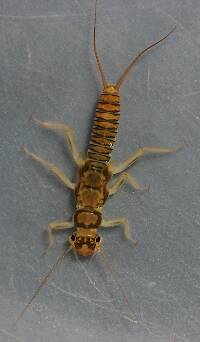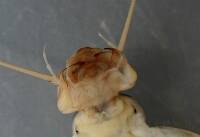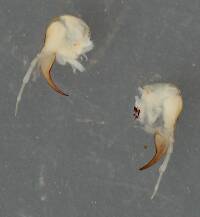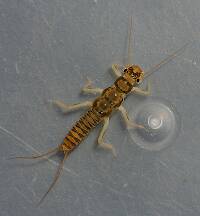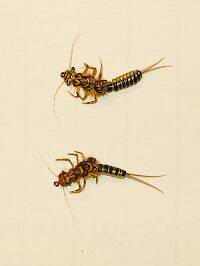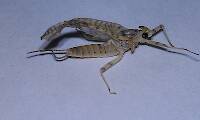
Blue-winged Olives
Baetis
Tiny Baetis mayflies are perhaps the most commonly encountered and imitated by anglers on all American trout streams due to their great abundance, widespread distribution, and trout-friendly emergence habits.
Featured on the forum

This specimen keys to the Epeorus albertae group of species. Of the five species in that group, the two known in Washington state are Epeorus albertae and Epeorus dulciana. Of the two, albertae has been collected in vastly more locations in Washington than dulciana, suggesting it is far more common. On that basis alone I'm tentatively putting this nymph in albertae, with the large caveat that there's no real information to rule out dulciana.

Troutnut is a project started in 2003 by salmonid ecologist Jason "Troutnut" Neuswanger to help anglers and
fly tyers unabashedly embrace the entomological side of the sport. Learn more about Troutnut or
support the project for an enhanced experience here.
Stclairj on Jan 16, 2013January 16th, 2013, 10:45 am EST
Hey all-
Last spring I posted with this same topic (see link below)
http://www.troutnut.com/topic/6595/Baetis-species-identification
I found these Baetis sp. in my vineyard, collected some samples, was supposed to send them to Bob Newell for help with identification, totally flaked on him, and basically the conversation came to an end.
Well, I had those samples saved in 80% alcohol for the past 8 months or so, and recently decided it was time to check them out. I also found on Amazon.com this microscope attachment for my Nikon D3100 for pretty cheap so I picked that up for fun. We have a couple microscopes in our lab at the winery.
Anyways, I am pretty sure I keyed them out correctly to Baetis tricaudatus, but I thought I would throw my first pictures up from the microscope attachment thing. Not great, still gonna take some messing around to get it dialed in, but I thought it was pretty cool.
What do you guys think based on these pictures as far as species? Any other pictures of specific body parts you would like to see?
Thanks in advance,
James
Last spring I posted with this same topic (see link below)
http://www.troutnut.com/topic/6595/Baetis-species-identification
I found these Baetis sp. in my vineyard, collected some samples, was supposed to send them to Bob Newell for help with identification, totally flaked on him, and basically the conversation came to an end.
Well, I had those samples saved in 80% alcohol for the past 8 months or so, and recently decided it was time to check them out. I also found on Amazon.com this microscope attachment for my Nikon D3100 for pretty cheap so I picked that up for fun. We have a couple microscopes in our lab at the winery.
Anyways, I am pretty sure I keyed them out correctly to Baetis tricaudatus, but I thought I would throw my first pictures up from the microscope attachment thing. Not great, still gonna take some messing around to get it dialed in, but I thought it was pretty cool.
What do you guys think based on these pictures as far as species? Any other pictures of specific body parts you would like to see?
Thanks in advance,
James
Oldredbarn on Jan 16, 2013January 16th, 2013, 6:58 pm EST
I don't know about anyone else, but I'm keenly interested in genitalia. ;)
"Even when my best efforts fail it's a satisfying challenge, and that, after all, is the essence of fly fishing." -Chauncy Lively
"Envy not the man who lives beside the river, but the man the river flows through." Joseph T Heywood
"Envy not the man who lives beside the river, but the man the river flows through." Joseph T Heywood
Entoman on Jan 16, 2013January 16th, 2013, 8:03 pm EST
Hi James,
I remember that fun topic. Glad to hear from you again!
Though the resolution is really good in certain spots, I don't see anything in the photos that helps me much. The best are 3 photos that show the whole critter - dorsal, ventral, & lateral. The laterals you took in the other thread were excellent, but it would have been better for our purpose if they were taken a little closer. If the quality is good enough they can be expanded on our screens to zoom in on any body part we want with excellent resolution. The biggest problem you'll have to deal with using your scope is an extremely shallow depth of field which means much of the subject in most photos will be out of focus. Mayfly determinations are usually subject to the analysis of many characters from different body parts often in relation to others so taking an isolated photo of a small area is rarely helpful.
I remember that fun topic. Glad to hear from you again!
Though the resolution is really good in certain spots, I don't see anything in the photos that helps me much. The best are 3 photos that show the whole critter - dorsal, ventral, & lateral. The laterals you took in the other thread were excellent, but it would have been better for our purpose if they were taken a little closer. If the quality is good enough they can be expanded on our screens to zoom in on any body part we want with excellent resolution. The biggest problem you'll have to deal with using your scope is an extremely shallow depth of field which means much of the subject in most photos will be out of focus. Mayfly determinations are usually subject to the analysis of many characters from different body parts often in relation to others so taking an isolated photo of a small area is rarely helpful.
"It's not that I find fishing so important, it's just that I find all other endeavors of Man equally unimportant... And not nearly as much fun!" Robert Traver, Anatomy of a Fisherman
Stclairj on Jan 17, 2013January 17th, 2013, 10:33 am EST
I did read about the depth of field with the microscope attachment, and knew that would be an issue. As I said, I am still messing around with it, and downloaded a program for image bracketing. I think the biggest problem as of now is the shutter speed. I can only get it down to about 1/40 sec with the available light. Since I bought the cheapo version of the microscopic attachment, it did not come with instructions, and so far I have not been able to figure out how to actually attach it to the eyepiece, so I am having to hand stabilize. So the combination of hand stabilization and low shutter speed is creating some fuzziness.
I guess for the pictures, I should have explained why I posted those specific two. I own "An Introduction to the Aquatic Insects of North America" by Merrit and Cummings, and used to use it quite a bit for an internship that I had in college. Skipping the obvious (we know it is in the family baetidae, and I am just talking myself through this at this point, correct me if I am wrong, I am also assuming most of you have this book), and moving down to Line 23, we know it is not Callibaetis, so we move to 24. The intercalaries of the forewing occur in pairs, so we move to line 28. At 28 (and this is one of the reasons I attached the picture of the hind wing), it appears that the basal interior margin does not form a straight line to the apex of the costal projection, so we move to 29, where the anterior process is neither coniform, nor does it project dorsally, so we move to 31. Again, in the picture of the hind wing we can see that there is an obvious costal process, so we move to 32. The costal process does not appear hooked to me, so we move to 33, and since hind wings are absent ni all known species of Apobaetis we move to 34. 34 is a little tricky for me, and here is where you all might chime in. There is a 3rd vein in the hind wing, but it does not look to be a fork of the second vein. It seems that it is a separate vein all togethor. Plus, the terminal segment of the forceps is not elongate. There is a side note at this point, that says B. magnus and/or B. diablus may key here if the terminal segment of the forceps is not elongate.
I attached 2 new pictures that are a little more magnified with somewhat better resolution.
Also, I am confused by the comment "Mayfly determinations are usually subject to the analysis of many characters from different body parts often in relation to others so taking an isolated photo of a small area is rarely helpful."
I can see where this is true trying to get to family, but for genus it seems like each step in the key is related to one body part only, or two body parts, but not in relation to one another, and most often it's the hind wing and the forceps/penes. Where I get stuck in the key pertains to these body parts, and not in relation to any other, so I guess that is why I posted these.
Anyways,take a look at the 2 new pics and let me know what you think.
I guess for the pictures, I should have explained why I posted those specific two. I own "An Introduction to the Aquatic Insects of North America" by Merrit and Cummings, and used to use it quite a bit for an internship that I had in college. Skipping the obvious (we know it is in the family baetidae, and I am just talking myself through this at this point, correct me if I am wrong, I am also assuming most of you have this book), and moving down to Line 23, we know it is not Callibaetis, so we move to 24. The intercalaries of the forewing occur in pairs, so we move to line 28. At 28 (and this is one of the reasons I attached the picture of the hind wing), it appears that the basal interior margin does not form a straight line to the apex of the costal projection, so we move to 29, where the anterior process is neither coniform, nor does it project dorsally, so we move to 31. Again, in the picture of the hind wing we can see that there is an obvious costal process, so we move to 32. The costal process does not appear hooked to me, so we move to 33, and since hind wings are absent ni all known species of Apobaetis we move to 34. 34 is a little tricky for me, and here is where you all might chime in. There is a 3rd vein in the hind wing, but it does not look to be a fork of the second vein. It seems that it is a separate vein all togethor. Plus, the terminal segment of the forceps is not elongate. There is a side note at this point, that says B. magnus and/or B. diablus may key here if the terminal segment of the forceps is not elongate.
I attached 2 new pictures that are a little more magnified with somewhat better resolution.
Also, I am confused by the comment "Mayfly determinations are usually subject to the analysis of many characters from different body parts often in relation to others so taking an isolated photo of a small area is rarely helpful."
I can see where this is true trying to get to family, but for genus it seems like each step in the key is related to one body part only, or two body parts, but not in relation to one another, and most often it's the hind wing and the forceps/penes. Where I get stuck in the key pertains to these body parts, and not in relation to any other, so I guess that is why I posted these.
Anyways,take a look at the 2 new pics and let me know what you think.
Entoman on Jan 17, 2013January 17th, 2013, 7:19 pm EST
The additional pictures are much more helpful. I think they show this is clearly baetis, most likely a form of tricaudatus. I've seen this wing conformation before in other examples of the species. You're working with an older version of Merritt so I won't add to the confusion by attempting to correlate couplets, especially since it stops at genus and it sounds like you used it properly to get there anyway.:)
To further the discussion regarding baetid species and hind wings, I wished they were more diagnostic but the reality is there is so much variability with this character that current thinking is they may not be as dependable as once thought. Even if they were, using them for a species determination from photos is problematic to say the least. Of the dozens of baetid threads we've engaged in here in the last couple of years I can honestly say that I can't think of a single one that fit the diagrams without some differences. Camera angle can significantly impact their perceived shape and sometimes even the orientation of the veins assuming the lighting even allows them to be seen properly. The same thing can be said about genitalia in that the diagrams usually come from properly cleared and prepared samples on slides. They often look quite different in photos where they are still attached to the (often still live) specimen.
Sorry about that. I was talking about photos in general. It is rare that an isolated photo of a particular body part will lead to an ID until after the family and usually genus is established. For example, If you had submitted the top two by themselves without relation to the other thread and absent any other information, the most I could of said was that it was a mayfly, probably baetid.
To further the discussion regarding baetid species and hind wings, I wished they were more diagnostic but the reality is there is so much variability with this character that current thinking is they may not be as dependable as once thought. Even if they were, using them for a species determination from photos is problematic to say the least. Of the dozens of baetid threads we've engaged in here in the last couple of years I can honestly say that I can't think of a single one that fit the diagrams without some differences. Camera angle can significantly impact their perceived shape and sometimes even the orientation of the veins assuming the lighting even allows them to be seen properly. The same thing can be said about genitalia in that the diagrams usually come from properly cleared and prepared samples on slides. They often look quite different in photos where they are still attached to the (often still live) specimen.
Also, I am confused by the comment "Mayfly determinations are usually subject to the analysis of many characters from different body parts often in relation to others so taking an isolated photo of a small area is rarely helpful."
Sorry about that. I was talking about photos in general. It is rare that an isolated photo of a particular body part will lead to an ID until after the family and usually genus is established. For example, If you had submitted the top two by themselves without relation to the other thread and absent any other information, the most I could of said was that it was a mayfly, probably baetid.
"It's not that I find fishing so important, it's just that I find all other endeavors of Man equally unimportant... And not nearly as much fun!" Robert Traver, Anatomy of a Fisherman
Feathers5
Posts: 287
Posts: 287
Feathers5 on Jan 18, 2013January 18th, 2013, 2:54 am EST
I don't know about anyone else, but I'm keenly interested in genitalia. ;)
Wow! I'll have to watch my back and front when I'm fishing with you.
Bruce
Oldredbarn on Jan 18, 2013January 18th, 2013, 7:03 am EST
Wow! I'll have to watch my back and front when I'm fishing with you.
Bruce
...and this from a guy who has hooked peacefully, grazing, cattle! ;) That was you right? All your personalities (nom de plumes) have me confused here.
Eventhough my comment was tongue-in-cheek...The working end of male mayflies are helpful when trying to figure out what tribe they're from. I just couldn't help myself there. My post was just before midnight and I may have been half asleep...
:)
Spence
"Even when my best efforts fail it's a satisfying challenge, and that, after all, is the essence of fly fishing." -Chauncy Lively
"Envy not the man who lives beside the river, but the man the river flows through." Joseph T Heywood
"Envy not the man who lives beside the river, but the man the river flows through." Joseph T Heywood
Quick Reply
Related Discussions
Topic
Replies
Last Reply
Re: Help obtaining photos of larval insects for a City of Denton, TX photographic key to ID'ing.
In the Identify This! Board by Rdjudy
In the Identify This! Board by Rdjudy
1
Jul 28, 2008
by Taxon
by Taxon
2
Feb 6, 2017
by Crepuscular
by Crepuscular




